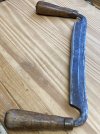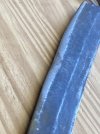I got a good deal on this from a local guy on Craigslist but it needs some work. My sharpening experience has evolved as far as “get a good edge/bevel and then frequently touch that up with high grit and honing before the tool gets too dull”. Grinding to straighten a wavy edge before sharpening is beyond my experience level. I would appreciate any and all suggestions and your preferred method.
Thanks,
Claus
Thanks,
Claus


